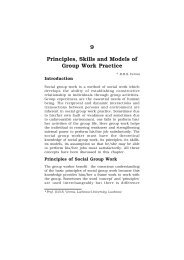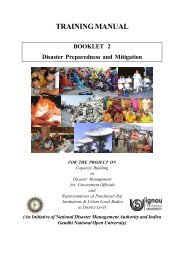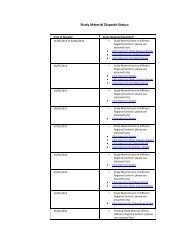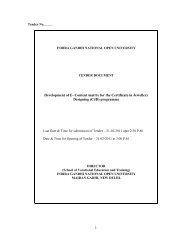Disaster Recovery and the Road Ahead - IGNOU
Disaster Recovery and the Road Ahead - IGNOU
Disaster Recovery and the Road Ahead - IGNOU
Create successful ePaper yourself
Turn your PDF publications into a flip-book with our unique Google optimized e-Paper software.
It is, <strong>the</strong>refore, essential that social welfare <strong>and</strong> psychological support<br />
measures should have a clear underst<strong>and</strong>ing of <strong>the</strong>se myths surrounding<br />
human behaviour. Such measures should be considered immediately<br />
after a disaster event, so that <strong>the</strong>y could be made a vital part of a<br />
rehabilitation programme.<br />
It should include:<br />
<br />
<br />
<br />
<br />
<br />
Identification of Key Problems<br />
Appointment of Counsellors <strong>and</strong> Psychiatrists<br />
Making Use of Social Networking Mechanisms <strong>and</strong> Stress<br />
Management<br />
Counselling, especially Peer Group Counselling<br />
Arranging Street Plays/Nukkad Nataks <strong>and</strong> Face-to-Face Interaction<br />
<strong>Disaster</strong> survivors normally experience a range of psychological <strong>and</strong> physiological reactions. The<br />
reactions of survivors may become more intense as <strong>the</strong><br />
amount of disruption to <strong>the</strong>ir lives increases. The strength<br />
<strong>and</strong> type of reaction varies with each person <strong>and</strong> depends<br />
upon several factors:<br />
Source: Street Play / Google Images /<br />
Jeevika.org<br />
affected person normally faces. These are:<br />
Impact Phase<br />
Inventory Phase<br />
Rescue Phase<br />
<strong>Recovery</strong> Phase<br />
i) In <strong>the</strong> impact phase, survivors do not panic <strong>and</strong> may,<br />
in fact, show no emotion. They do what <strong>the</strong>y must to<br />
respond to <strong>the</strong> situation, <strong>and</strong> try to keep <strong>the</strong>mselves <strong>and</strong><br />
<strong>the</strong>ir families alive<br />
<br />
<br />
<br />
<br />
Prior experience with a similar event<br />
Time <strong>and</strong> intensity of disruption<br />
Emotional strength of individual<br />
Source: 2009-Andhra-Pradesh/<br />
Google Images<br />
Presence of feelings that <strong>the</strong>re is no escape<br />
Survivors may go through distinct emotional phases<br />
following a disaster. There are four distinct phases that an<br />
ii)<br />
In <strong>the</strong> inventory phase, which immediately follows <strong>the</strong><br />
disaster event, survivors are engaged in assessing <strong>the</strong><br />
damage <strong>and</strong> trying to locate o<strong>the</strong>r survivors. During this<br />
phase, routine social ties tend to pave way for more<br />
functional ones, required for initial response activities<br />
such as searching for family members <strong>and</strong> seeking<br />
medical assistance<br />
Source: Photo Gallery: <strong>Disaster</strong> Relief <strong>and</strong><br />
Rehabilitation/The Family International FIles<br />
41

















